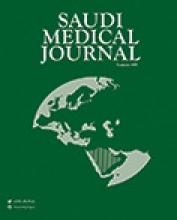Abstract
OBJECTIVE: Helicobacter pylori (H. pylori) infection is a major cause of various upper gastrointestinal (UGI) disorders. The aim of this study was to determine the prevalence of H. pylori among patients with dyspepsia.
METHODS: A prospective study was carried out in the Gastroenterology Division, King Fahd Central Hospital, Gizan, Kingdom of Saudi Arabia from January 1995 to December 1998. Four hundred and eighty-eight patients with dyspepsia were consecutively examined using the UGI endoscopy during a 4-year period. Data analyzed included demographic details, clinical indications for the examination, endoscopic findings and results of the histopathologic assessment for H. pylori.
RESULTS: Overall, H. pylori were detected in 268 (54.9%) of the gastric biopsies from 488 patients (322 males and 166 females, aged 13-90 years). Helicobacter pylori infection was present in 140 (60.1%) of 253 patients with chronic gastritis diagnosed by endoscopy and in 49 (62.8%) of 78 patients with duodenal ulcers (DU). The rate in DU patients was significantly higher than the rate (43.6%) in patients with normal endoscopic findings (odds ratio [OR]=2.18, 95% confidence interval [CI] 1.02-4.70; p=0.04]. Of 455 biopsies with histologic gastritis, 268 (OR=58.9%, 95% CI 54.2-63.4) were positive for H. pylori and all specimens (n=33) with no histological evidence of gastritis were negative.
CONCLUSION: The well-described association of H. pylori with DU and non-ulcer dyspepsia was confirmed by our study. However, the rate of H. pylori in our patients was at the lower end of the range (50-80%), which was previously reported among largely urban populations in Saudi Arabia suggests differences in the prevalence of H. pylori-infections between urbanized and rural populations. Helicobacter pylori negative peptic ulcer disease remains an important entity that may be associated with the use of non-steroidal anti inflammatory drugs and in our environment, the habitual chewing of qat leaves (catha edulis).
- Copyright: © Saudi Medical Journal
This is an open-access article distributed under the terms of the Creative Commons Attribution-Noncommercial-Share Alike 3.0 Unported, which permits unrestricted use, distribution, and reproduction in any medium, provided the original work is properly cited.






